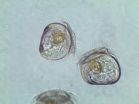Public outcries about sudden cardiac deaths among athletes have already prompted some European countries to require that young athletes undergo heart exams via ECG before they participate in sports. Even though the number of sudden cardiac deaths among young U.S. athletes is low — an estimated 76 per year —some people have suggested that athletes here should also receive mandatory ECGs so that those vulnerable to sudden cardiac death could be warned not to play sports.
Not so fast, say the authors of the new research.
"An ECG doesn't always pick up the abnormalities that may predispose someone to sudden cardiac death," said Allison Hill, MD, the study's first author. "And this exam can be difficult to interpret, even if the person reading the scan is a pediatric cardiologist." Hill recently finished her pediatric residency at Packard Children's Hospital and is now a pediatric cardiology fellow at Children's Hospital Boston.
An ECG exam uses electrodes attached to the chest and limbs to measure the electrical impulses generated as the heart beats. ECGs can detect heart rhythm abnormalities and other symptom-free heart conditions that could lead to sudden cardiac death.
In the new study, which will be published online July 14 in the Journal of Pediatrics, 53 members of the Western Society of Pediatric Cardiology were asked to interpret a set of 18 ECG exams, some from healthy athletes and some from those with heart defects. The physicians, who had an average of five to 15 years of experience in their field, accurately diagnosed the heart conditions only 67 percent of the time. They correctly permitted sport participation for healthy individuals 74 percent of the time, and correctly restricted sport participation for those with cardiac defects 81 percent of the time.
"As athletes' hearts grow stronger, they undergo some changes that make it very difficult to tell: Is this a well-trained athlete or does this person have some underlying disorder that may predispose them to sudden cardiac death?" Hill said. A fit heart tends to grow somewhat larger and beat more slowly, which can make it look similar on an ECG to a defective heart vulnerable to sudden cardiac death. This similarity could lead to unnecessary exclusion of healthy young people from sport participation.
Conversely, some young athletes who are predisposed to sudden cardiac death may be given a clean bill of health based on a flawed ECG interpretation.
"We need to be careful about giving a false sense of security to families, parents or an entire community if we have an ECG that's normal," Hill said. "It's important to know that it's not a perfect test."
The physicians' accuracy at interpreting ECGs varied depending on what heart defect they were looking at. They were most accurate at picking up long QT syndrome and myocarditis, showing 98 percent and 90 percent accuracy at restricting sport participation for these two conditions. In contrast, they correctly restricted sport participation for patients with hypertrophic cardiomyopathy, Wolff-Parkinson-White syndrome and pulmonary arterial hypertension 80 percent, 64 percent and 38 percent of the time, respectively. (The poor result for pulmonary arterial hypertension may be due to the fact that it is much rarer than the other diagnoses, occurring in 30-50 people per million, whereas most of the other diagnoses are seen at a rates between one in 10,000 and one in 100 people.)
The new results dovetail with the current American Heart Association position on pre-sport ECGs, which recommends against routine use of the exams because of the large number of athletes in the United States, the low frequency of diseases leading to sudden cardiac death, the low rate of sudden cardiac death itself and the frequent false-positives that could unjustly exclude healthy individuals from sport participation. The AHA instead recommends a thorough history and physical exam every two years for young athletes.
A different Stanford study on ECGs for athletes, published in 2010, suggested ECGs for young athletes would be cost-effective. However, that study started from the assumption that ECGs would all be interpreted accurately, said cardiologist Euan Ashley, MD, who led the cost-effectiveness research.
If the United States does start instituting screening programs, Hill and her colleagues suggest that there is a need to ensure the physicians reading these ECGs are trained appropriately, which would add to the total load of information that pediatric cardiologists must already learn during their three-year training. It would also be important for physicians to use the proper normal values when evaluating these scans. Currently, there is not good consensus on what constitutes "normal" for a trained athlete's heart, said co-author Anne Dubin MD, associate professor of pediatric cardiology, adding that data from such individuals exists but has not been widely shared.
###
The other co-author of the work is Christina Miyake, MD, instructor in pediatric cardiology.
Additional information about the Department of Pediatrics, which supported the research, is available at http://pediatrics.stanford.edu/.
The Stanford University School of Medicine consistently ranks among the nation's top medical schools, integrating research, medical education, patient care and community service. For more news about the school, please visit http://mednews.stanford.edu. The medical school is part of Stanford Medicine, which includes Stanford Hospital & Clinics and Lucile Packard Children's Hospital. For information about all three, please visit http://stanfordmedicine.org/about/news.html.
Celebrating its 20th anniversary in 2011, Lucile Packard Children's Hospital is annually ranked as one of the nation's best pediatric hospitals by U.S. News & World Report, and is the only San Francisco Bay Area children's hospital with programs ranked in the U.S. News Top Ten. The 311-bed hospital is devoted to the care of children and expectant mothers, and provides pediatric and obstetric medical and surgical services in association with the Stanford University School of Medicine. Packard Children's offers patients locally, regionally and nationally a full range of health-care programs and services, from preventive and routine care to the diagnosis and treatment of serious illness and injury. For more information, visit www.lpch.org.
PRINT MEDIA CONTACT: Erin Digitale at (650) 724-9175 (digitale@stanford.edu)
BROADCAST MEDIA CONTACT: Robert Dicks at (650) 497-8364 (rdicks@lpch.org)
END

